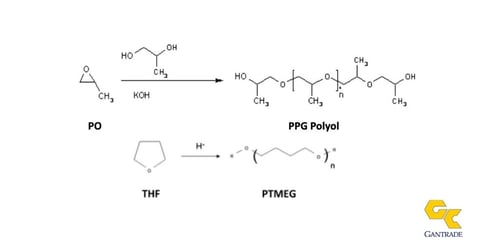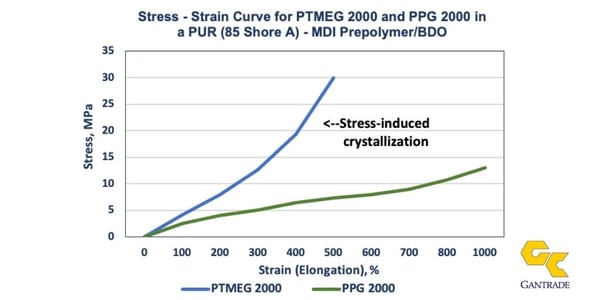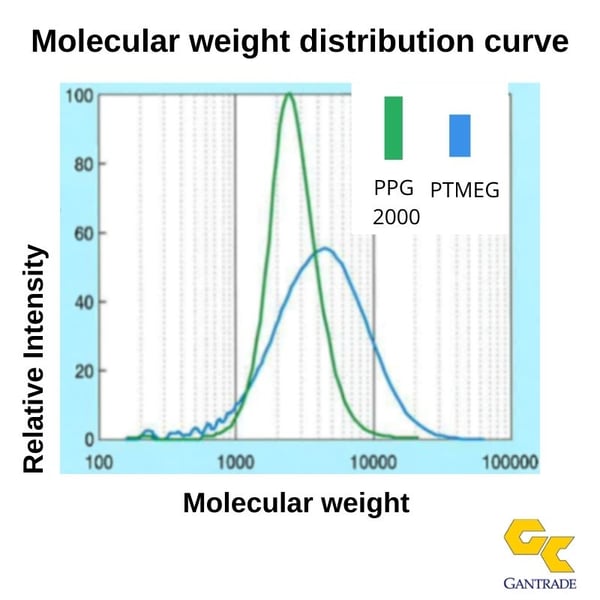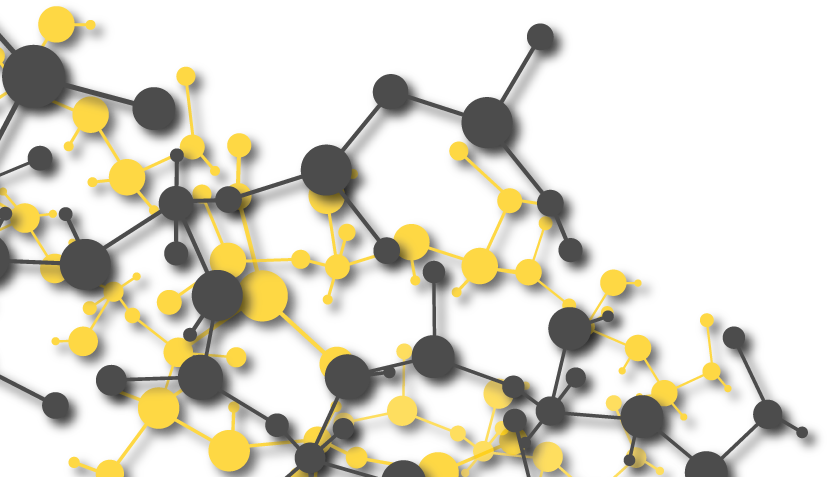The two major families of polyether polyols are polytetramethylene ether glycols (PTMEG) and polypropylene glycols (PPG). PTMEG is the premier polyol used in high-performance polyurethane elastomers. PTMEG-based polyurethanes exhibit superior resistance to hydrolytic cleavage, good mechanical property retention at low temperature, high resiliency, good processing characteristics, and excellent mechanical and dynamic properties. Strain-induced crystallization of the PTMEG soft segments, exact di-functionality, and low acid values are all contributing factors to the good mechanical properties of the associated polyurethane elastomers. PPG polyols have excellent hydrolysis resistance and low temperature properties as well. However, when compared to PTMEG polyols, the PPG polyols have lower mechanical properties and are more prone to thermo-oxidative degradation.
Balancing Polyurethane Elastomer Performance with Blends of PTMEG and PPG Polyols
Blending of PTMEG and PPG polyols can allow optimizing of properties and costs in polyether based polyurethane formulations. These polyol blends can create value in application such as PUR adhesives, cast polyurethane elastomers, thermoplastic polyurethanes and polyurethane dispersion coatings. Performance enhancements achieved by incorporating PTMEG into PPG polyols include tensile, tear and rebound properties, enhanced dynamic performance under cyclic loading, and more favorable tack-adhesion-cohesion balances. The lower cost PPG polyols can improve tack, “cold-hardening” characteristics and softness in PTMEG elastomers while balancing cost-performance profiles. PTMEG and PPG polyols are not co-miscible, so polyurethane elastomers will lack clarity.
To begin to understand the science behind achieving performance optimizations, it is valuable to look at the science underlying the differences between the PTMEG polyols and the PPG polyols.
PTMEG Polyols vs. PPG Polyols
Both PTMEG and PPG polyols are polyethers, which impart good low temperature properties and excellent hydrolytic stability to polyurethane elastomers. Both polyether classes exhibit very low Tg’s in the soft segment of polyurethanes. The Tg of PTMEG polyol (Tg ~ 75°C) is lower than that of PPG polyols (~65°C). In addition, PTMEG has a uniform linear structure, which allows it to tightly pack in a PUR soft segment and undergo stress-induced crystallization. Stress crystallization results in a significant increase in the tensile properties, with a reduction in the ultimate elongation. PPG polyols are more complex structures with pendant methyl group that disrupt chain packing and afford non-crystallizable amorphous soft segment structures. As a result, PPG polyols in a PUR elastomer do not “cold harden”, a beneficial feature.
The basic chemical structures and the synthetic routes to both polyether polyols are shown below.

The table below compares the key characteristics and properties of PTMEG and PPG polyols.
| PTMEG | PPG Polyols | Comments | |
| Backbone Structure | Linear Aliphatic Polyether | Branched Aliphatic Polyether | Linear structures enhance van der Waals intermolecular forces |
| Crystallization Characteristics | Crystallizable | Does not crystallize | Stress crystallization affords performance enhancements |
| Hydroxyl End-Group | 100% primary -OH | Secondary -OH. 3-4% unsaturated chain ends | < 100% -OH chain ends reduce network formation, a negative |
| MWD:MW/MN | Moderate: 1.8-2.1 | Narrow: 1.02-1.08 | MWD influences properties and viscosity |
| PUR Mechanical Properties | Excellent | Good | PTMEG affords high tensile, resiliency and abrasion properties |
| Prepolymer Viscosities | Medium | Low | Low viscosities facilitate handling and processing |
The information in the above table provides useful guidance for formulating polyol blends to optimize specific performance features in a PUR elastomer.
Principles of Structure-Property Relationships
The linear structure of PTMEG promotes greater net van der Waals intermolecular interactions within the soft segment of PURs, thereby increasing mechanical and cohesive properties of the elastomer. Van der Waals forces are molecular-distance dependent and greater in structures that closely pack. The pendant methyl group in the PPG repeat unit sterically interferes with molecular packing and the van der Waals forces of attraction are thereby weakened. Blending of the PTMEG and PPG polyols in a PUR will alter the extent of the van der Waals interactions and allow a fine-tuning of properties like stress-induced crystallization, hard block phase separation, tack and adhesive properties, and cut and tear properties, etc. Some of these effects will be described later. Elongation induced crystallization is generally accepted to occur as the soft segment chains orient in the direction of the elongation.

Increasing the percentages of PPG polyol in a blend with PTMEG suppresses the crystallization tendencies in the soft segment and reduces the cold and stress-induced crystallization behavior associated with the PTMEG component. Some indications of stress-induced crystallization continued to be detected even at a level of only 50% PTMEG in the soft segment. Studies observing the soft segment Tg’s of blends of PTMEG and PPG polyols also suggest there is miscibility between the two polyols in a polyurethane elastomer. 1
Another key property difference between the PTMEG polyols and PPG polyols is their molecular weight distributions (MWDs), MW/MN, as shown in the figure below. PTMEG polyols have a broader MWD vs. the PPG polyols which are characterized by very narrow MWD. Polyol MWD can have a significant effect on the handling, mechanical and dynamic properties in a PUR elastomer.

PTMEGs with a broader MWD have higher fractions of both low-MW diol molecules and high-MW chains compared with narrow MWD PPG polyols. The short chain diol fraction in PTMEG can become part of the hard-block segment thus increasing the concentration of the hard phase and significantly increasing the modulus and hardness of the elastomer. An increase in the hard phase volume generates additional restraints on the mobility of the soft segments, thereby reducing the rate and extent of cold and stress-induced crystallization of the PTMEG. Using PTMEG 1000 (vs. PTMEG 2000) would result in a higher fraction of the low-MW diol species contributing to the hard segment and thus have higher impact on suppressing blend crystallization.
The high molecular weight fraction associated with a broad MWD leads to an increase in the resiliency and rebound properties and an improvement in phase separation within the PUR elastomer. Accordingly, the addition of PTMEG to a PPG polyol enhances hardness, tensile properties and the resiliency and rebound properties of the associated PUR elastomer. Addition of PPG polyols into a blend results in lower Durometer, softer polyurethane elastomers. PPG polyols result in a dilution in the low-MW diol fraction of the PTMEG polyol with a reduction in the hard-block concentration.
Polyether Polyol Blends in Adhesive Applications
The balance of tack, adhesion and cohesion forces are core elements in the design of adhesives. In Pressure Sensitive Adhesives (PSAs), tack, shear strength and peel strength are additional controlling properties. While the selection of polyol employed and hard block-soft block ratio are used in optimizing the adhesive properties of a TPU, blending PTMEG with PPG polyols provides another dimension to the design of adhesives.
The principles laid-out above help to guide the selection of polyol blend ratios in optimizing the required adhesive properties. For the reasons cited above, PTMEG, which is crystallizable, show greater adhesion and cohesion characteristics in a PUR. PPG polyols enhance tack and adhesion to hydrophobic surfaces and improve handling characteristics like viscosity. Altering the ratio of PTMEG and PPG polyols in blends allows an optimization of adhesive properties to meet various performance criteria. In one study, excellent combinations of tack, shear, and peel properties were obtained in a PSA produced from a 50:50 blend of PTMEG and PPG polyols. 2
Polyol Blends in Cast PUR Elastomers
In one shot cast polyurethane elastomers, reactivity, and cure rates/demold times in a polyol/MDI/BDO system are much faster with a PTMEG polyol vs. a PPG polyol. This reflects the 100% primary hydroxy di-functionality in a PTMEG. PPG polyols made with a conventional KOH catalyst contain 3-4 mole percent of mono-hydroxy concentrations (the other terminus being allyl unsaturation) and lower reactivity secondary hydroxyl functionality. Virtually all final elastomer properties improve with the addition of PTMEG in a blend with a PPG polyol. This includes hardness, tensile and tear strengths, resiliency and rebound properties, abrasion, tensile and compression set. There are multiple factors associated with these improvements: 1) the overall superior mechanical properties of the linear PTMEG structure, 2) stress-induced crystallization at high levels of PTMEG, 3) fewer chain ends due to the high 2.0 functionality of the PTMEG diol, and 4) an increase in the overall polymer MW achievable. For these reasons, PPG polyols produced by the KOH process are more often used in polyurethane foam applications and less so in cast and TPU elastomers. Double Metal Cyanide (DMC) catalysts produce PPG polyols with high difunctionality and low mono-unsaturation contents. DMC catalysts are used for high MW and elastomer grade PPG polyols.
Studies have reported that as little as 10-20 weight percent of a PPG polyol in PTMEG begins to affect the stress crystallization of PTMEG polyols, with an associate increase in ultimate elongations.3
Polyol Blends in TPUs and Prepolymer Cast Elastomers
In prepolymers and TPUs, the low viscosity of the PPG polyols can offer processing advantages. With regard to the mechanical properties, the same trends as discussed for cast elastomers apply to prepolymer based systems and TPUs. The overall magnitude of the property differences can be bridged using blends of PTMEG and PPG polyols in elastomeric polyurethanes.
Polyurethane Elastomer Summary
Blending of PTMEG and PPG polyols allow optimizing of properties and costs in polyether polyurethane formulations. Addition of PTMEG to PPG polyols enhances tensile, tear and rebound/resilience properties, dynamic properties, and adhesion-cohesion in adhesives. The PPG polyols can improve tack, “cold-hardening” characteristics, softness, and processing in PTMEG elastomers, while reducing raw material costs.
These polyol blends can create value in polyurethane application such as adhesives, cast polyurethane elastomers, TPUs and polyurethane dispersion coatings.
To explore how our range of urethane intermediates can address your unique polyurethane elastomer applications, partner with Gantrade Corporation. Our expert teams, armed with a wealth of technical knowledge and experience, can guide you to the best solutions for your applications. Contact Gantrade today to get started.
Looking for an expert PTMEG supplier? Our commitment to global logistics ensures efficient and dependable sourcing. Download a PTMEG Brochure to learn more.
1 From Structure–property relationships of poly(urethane‐urea)s with ultralow monol content poly(propylene glycol) soft segments (Abstract), by Matthew J. O'Sickey Bruce D. Lawrey Garth L. Wilkes, 2003, The Journal of Applied Science, 89: 3520–3529. Copyright 2003 by Wiley Periodicals, Inc.
2 From Fuensanta M and Martín-Martínez JM (2020) Viscoelastic and Adhesion Properties of New Poly(Ether-Urethane) Pressure-Sensitive Adhesives. Front. Mech. Eng. 6:34. doi: 10.3389/fmech.2020.00034.
3From Ultra-Low Monol PPG: High-Performance Polyether Polyols for Polyurethanes (2001) , by Stephen D. Seneker, Nigel Barksby and Bruce D. Lawrey, Advances in Urethane Science and Technology, 9:421. Copyright ©2001, Rapra Technology Limited.













